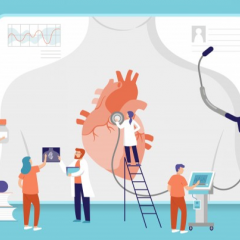Using Artificial Intelligence for Aneurysm Rupture Risk Monitoring
HealthITAnalytics Cerebral aneurysms, also known as intracranial or brain aneurysms, present a unique challenge for clinicians, as most are small dilations that occur at weak points along the arteries of the brain and have no symptoms. However, as the aneurysm grows, the risk of rupture increases. Once the aneurysm expands and the blood vessel wall becomes too thin, the aneurysm will rupture, causing...
More Features
Using a Patient-Reported Outcome Tool to Make EHR Data Actionable
EHRs play a critical role in guiding care coordination and delivery, but interoperability challenges can prevent EHR data from being used effectively to improve patient care. Addressing these issues is a major focus for healthcare...
Exploring Decentralized Architecture Networks in Healthcare
Efficient and secure health data interoperability is a top priority for providers, payers, and other healthcare stakeholders, but enabling interoperability remains a major challenge for many organizations across the country. To support...
How Does the White House AI Bill of Rights Apply to Healthcare?
In October, the White House unveiled its Blueprint for an AI Bill of Rights, providing guidelines for the design, use, and deployment of AI-based tools to protect Americans from harm as the use of these technologies continues to grow in...
Mass General, Mayo Clinic, & More Share AI, Analytics Plans for Next Year
As 2022 draws to a close, health systems are gearing up for new opportunities and challenges in the year ahead. For many, top priorities from last year, such as patient access to care and efficiency improvements, will carry over into 2023....
Leveraging Location Analytics to Address the Opioid Epidemic
Addressing the opioid crisis has become a top public and population health priority in recent years, and big data analytics solutions to address the issue have been proposed and implemented by healthcare organizations across the country....
Using AI to Streamline the Provider-Payer Relationship
Providers and payers play key roles in healthcare delivery. More often than not, the two must collaborate to ensure that patients and beneficiaries move through their care journeys as efficiently as possible while complying with state and...
How a Data-Driven Command Center Can Improve ED Outcomes
Emergency departments (EDs) serve as an integral front door in hospital systems, supporting numerous patients requiring acute care or inpatient admission on a daily basis. However, healthcare-wide challenges such as capacity management and...
Leveraging a Technology Accelerator to Drive Addiction Treatment Success
Effective treatments that lead to improved patient outcomes are what clinicians strive to provide for their patients across healthcare settings and specialties. But there may be many hurdles to treatment success depending on the condition,...
Achieving Clinician Buy-In to Drive AI Adoption in OR Scheduling
Clinician buy-in is critical for large-scale improvement and innovation projects within a health system, including those requiring artificial intelligence (AI) and machine learning (ML) adoption. However, issues such as burnout and...
How Children’s of Alabama Uses Real-Time Analytics to Support ICU Liberation
As many healthcare organizations move toward value-based care, they must create and implement strategies to improve the quality of care and reduce the risk of adverse patient outcomes in the short and long term. Strategies differ by type of...
How Actionable Patient Genomic Data Can Boost Precision Medicine
Genomics and precision medicine are exciting prospects for healthcare organizations looking to personalize care to improve disease prevention and clinical outcomes for their patients. However, implementation and utilization remain a...
Using Self-Reported Patient Data to Advance Lung Disease Care
Lung disease is a significant source of morbidity, mortality, and financial burden in the United States. However, those working to advance patient care and research in this area posit that many of the hurdles faced by patients, families,...
How AI Can Help Alleviate Black Maternal Health Disparities
Maternal and infant health are prevalent population health concerns, especially in the wake of the COVID-19 pandemic and the baby formula shortage. But those working toward health equity are raising the alarm and pointing out that maternal...
Leveraging Data Analytics, Clinical Intelligence to Bolster Perioperative Care
Healthcare organizations are continually looking for ways to improve efficiency and optimize workflows without burdening staff or patients. However, with staffing and resource shortages plaguing health systems since the beginning of the...
How Limitations in AI, Wearables Impact Depression Research
Artificial intelligence (AI) and wearables have seen an uptick in interest from the healthcare sector in recent years. With the rise in demand for telemental healthcare during the pandemic, the push for digital transformation in mental...
Using Data Analytics to Improve Primary Care, Referral Management
Primary care is an essential facet of modern healthcare, serving as the conduit through which many patients access and engage with available medical care services. When a patient has a non-emergency health concern, a primary care physician...
How Intelligent Automation Can Help Close Care Gaps, Boost Patient Outreach
In the US, access to and quality of healthcare are major drivers of health disparities and widening patient care gaps. Bridging care gaps also requires providers to have access to knowledge and resources to support these efforts, which can...
Using Real-World Data to Improve Cancer Care Delivery, Precision Medicine
As efforts to reduce and eventually eliminate cancer, such as President Biden’s Cancer Moonshot, gain traction, providers are tasked with finding ways to improve cancer care delivery and research. As a result, the healthcare industry...
How Data Analytics Can Help Breast Milk Banks Be More Efficient
In the wake of the recent baby formula shortage, parents and providers are becoming increasingly interested in other methods for providing adequate nutrition to infants who may need it. Breast milk donation banks have long played a role in...
















